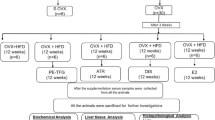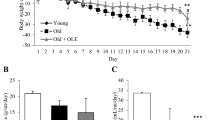Abstract
Background and aims: Although the cardioprotective effects of supplemental doses of vitamin E have been investigated in several conditions, its role in gonadectomy- induced fatty lesion formation is unclear. The present study was designed to examine the efficacy of vitamin E in a dose-dependent manner on indices of oxidative stress and in preventing the formation of aortic fatty lesions in orchidectomized (Orx) aged rats. Methods: Forty 12-month old male Sprague-Dawley rats were either sham-operated (Sham) or Orx and fed a semi-purified control diet for 120 days. Thereafter, rats were assigned to four treatment groups (n=10): Sham and one Orx group received 75 IU vitamin E and served as controls, and the other two Orx groups received either 250 or 500 IU vitamin E per kg diet for 90 days. Results: Vitamin E at the highest dose (500 IU) was able to lower serum total cholesterol by 16% and significantly increase superoxide dismutase by 9% compared to Orx controls. Similarly, this dose was able to significantly reduce the development of atherosclerotic lesion formation and aortic fatty streak area by 93% compared to Orx controls. Conclusions: The findings of this study suggest that dietary vitamin E supplementation in Orx aged rats provide anti-atherogenic effects, in part, due to vitamin E’s antioxidative properties. Clinical studies are needed to confirm whether supplemental doses of vitamin E can prevent the development of atherosclerosis in older men particularly with low testosterone level.
Similar content being viewed by others
References
O’Connor S, Taylor C, Campbell LA, Epstein S, Libby P. Potential infectious etiologies of atherosclerosis: a multifactorial perspective. Emerg Infect Dis 2001; 7: 780–8.
Schwenke DC, Behr SR. Vitamin E combined with selenium inhibits atherosclerosis in hypercholesterolemic rabbits independently of effects on plasma cholesterol concentrations. Circ Res 1998; 83: 366–77.
Surekha RH, Srikanth BB, Jharna P, et al. Oxidative stress and total antioxidant status in myocardial infarction. Singapore Med J 2007; 48: 137–42.
Nakamura YK, Read MH, Elias JW, Omaye ST. Oxidation of serum low-density lipoprotein (LDL) and antioxidant status in young and elderly humans. Arch Gerontol Geriatr 2006; 42: 265–76.
Rosenblat M, Coleman R, Aviram M. Increased macrophage glutathione content reduces cell-mediated oxidation of LDL and atherosclerosis in apolipoprotein E-deficient mice. Atherosclerosis 2002; 163: 17–28.
Nathan CF. Secretory products of macrophages. J Clin Invest 1987; 79: 319–26.
Harman D. Aging and oxidative stress. J Int Fed Clin Chem 1998; 10: 24–7.
Dunajska K, Milewicz A, Szymczak J et al. Evaluation of sex hormone levels and some metabolic factors in men with coronary atherosclerosis. Aging Male 2004; 7: 197–204.
Stulnig TM, Jurgens G, Chen Q et al. Properties of low density lipoproteins relevant to oxidative modifications change paradoxically during aging. Atherosclerosis 1996; 126: 85–94.
Pandya DP. Oxidant injury in coronary heart disease (Part-I). Compr Ther 2001; 27: 284–92.
Haffner SM, Mykkanen L, Valdez RA, Katz MS. Relationship of sex hormones to lipids and lipoproteins in nondiabetic men. J Clin Endocrinol Metab 1993; 77: 1610–5.
Zmuda JM, Cauley JA, Kriska A et al. Longitudinal relation between endogenous testosterone and cardiovascular disease risk factors in middle-aged men. A 13-year follow-up of former Multiple Risk Factor Intervention Trial participants. Am J Epidemiol 1997; 146: 609–17.
Jira W, Spiteller G, Schramm A. Increase in hydroxy fatty acids in human low density lipoproteins with age. Chem Phys Lipids 1996; 84: 165–73.
Kapoor D, Jones TH. Androgen deficiency as a predictor of metabolic syndrome in aging men: an opportunity for intervention? Drugs Aging 2008; 25: 357–69.
Stampfer MJ, Hennekens CH, Manson JE et al. Vitamin E consumption and the risk of coronary disease in women. N Engl J Med 1993; 328: 1444–9.
Meyer F, Bairati I, Dagenais GR. Lower ischemic heart disease incidence and mortality among vitamin supplement users. Can J Cardiol 1996; 12: 930–4.
Sigounas G, Anagnostou A, Steiner M. dl-alpha-tocopherol induces apoptosis in erythroleukemia, prostate, and breast cancer cells. Nutr Cancer 1997; 28: 30–5.
Keaney JF Jr, Simon DI, Freedman JE. Vitamin E and vascular homeostasis: implications for atherosclerosis. FASEB J 1999; 13: 965–75.
Saremi A, Arora R. Vitamin E and Cardiovascular Disease. Am J Ther 2010; 17: e56–65.
Elliott TG, Barth JD, Mancini GB. Effects of vitamin E on endothelial function in men after myocardial infarction. Am J Cardiol 1995; 76: 1188–90.
Simons LA, von KM, Simons J, Stocker R, Celermajer DS. Vitamin E ingestion does not improve arterial endothelial dysfunction in older adults. Atherosclerosis 1999; 143: 193–9.
Katsiki N, Manes C. Is there a role for supplemented antioxidants in the prevention of atherosclerosis? Clin Nutr 2009; 28: 3–9.
Hemila H, Kaprio J. Modification of the effect of vitamin E supplementation on the mortality of male smokers by age and dietary vitamin C. Am J Epidemiol 2009; 169: 946–53.
Wexler BC. Spontaneous arteriosclerosis in old, male, virgin Sprague-Dawley rats. Atherosclerosis 1979; 34: 277–90.
Searcy RL, Bergquist LM. A new color reaction for the quantitation of serum cholesterol. Clin Chim Acta 1960; 5: 192–9.
Folch J, Lees M, Sloane-Stanley GH. A simple method for the isolation and purification of total lipides from animal tissues. J Biol Chem 1957; 226: 497–509.
Auger C, Caporiccio B, Landrault N et al. Red wine phenolic compounds reduce plasma lipids and apolipoprotein B and prevent early aortic atherosclerosis in hypercholesterolemic golden Syrian hamsters (Mesocricetus auratus). J Nutr 2002; 132: 1207–13.
Kaplan M, Hayek T, Raz A et al. Pomegranate juice supplementation to atherosclerotic mice reduces macrophage lipid peroxidation, cellular cholesterol accumulation and development of atherosclerosis. J Nutr 2001; 131: 2082–9.
Fuhrman B, Rosenblat M, Hayek T, Coleman R, Aviram M. Ginger extract consumption reduces plasma cholesterol, inhibits LDL oxidation and attenuates development of atherosclerosis in atherosclerotic, apolipoprotein E-deficient mice. J Nutr 2000; 130: 1124–31.
Lucas EA, Chen TY, Chai SC et al. Effect of vitamin E on lipid parameters in ovariectomized rats. J Med Food 2006; 9: 77–83.
Aydilek N, Aksakal M. Effects of testosterone on lipid peroxidation, lipid profiles and some coagulation parameters in rabbits. J Vet Med A Physiol Pathol Clin Med 2005; 52: 436–9.
Christoffersen B, Raun K, Svendsen O, Fledelius C, Golozoubova V. Evalution of the castrated male Sprague-Dawley rat as a model of the metabolic syndrome and type 2 diabetes. Int J Obes (Lond) 2006; 30: 1288–97.
Lipid Research Clinics. The Prevalence Study. Department of Health and Human Services 2009, Vol 1.
Bhasin S, Bagatell CJ, Bremner WJ et al. Issues in testosterone replacement in older men. J Clin Endocrinol Metab 1998; 83: 3435–48.
Jockenhovel F, Bullmann C, Schubert M et al. Influence of various modes of androgen substitution on serum lipids and lipoproteins in hypogonadal men. Metabolism 1999; 48: 590–6.
Makinen J, Jarvisalo MJ, Pollanen P et al. Increased carotid atherosclerosis in andropausal middle-aged men. J Am Coll Cardiol 2005; 45: 1603–8.
Jones RD, Nettleship JE, Kapoor D, Jones HT, Channer KS. Testosterone and atherosclerosis in aging men: purported association and clinical implications. Am J Cardiovasc Drugs 2005; 5: 141–4.
Kravchenko AI, Provotorov VM. Acquired androgenic deficit and coronary heart disease. Klin Med 2008; 86: 4–7.
Agledahl I, Hansen JB, Svartberg J. Postprandial triglyceride metabolism in elderly men with subnormal testosterone levels. Asian J Androl 2008; 10: 542–9.
Borst SE, Conover CF. Orchiectomized Fischer 344 male rat models body composition in hypogonadal state. Life Sci 2006; 79: 411–5.
Notomi T, Okazaki Y, Okimoto N et al. Effects of tower climbing exercise on bone mass, strength, and turnover in orchidectomized growing rats. J Appl Physiol 2002; 93: 1152–8.
Vandenput L, Boonen S, Van HE et al. Evidence from the aged orchidectomized male rat model that 17beta-estradiol is a more effective bone-sparing and anabolic agent than 5alpha-dihydrotestosterone. J Bone Miner Res 2002; 17: 2080–6.
Deyhim F, Gonzales C, Garcia C et al. Vitamin E does not modulate plasma lipid profile or C-reactive protein despite suppressing oxidative stress in orchiectomized rats. J Med Food 2007; 10: 559–62.
Torres M, Marquez M, Sutil R et al. A study about the effect of vitamin E on hyperlipidemia and atherosclerotic lesions in New Zealand white rabbits fed with a 1% cholesterol rich diet. Invest Clin 2003; 44: 119–27.
Steinberg D. A critical look at the evidence for the oxidation of LDL in atherogenesis. Atherosclerosis 1997; 131 (Suppl): S5–7.
Berliner JA, Heinecke JW. The role of oxidized lipoproteins in atherogenesis. Free Radic Biol Med 1996; 20: 707–27.
Author information
Authors and Affiliations
Corresponding author
Rights and permissions
About this article
Cite this article
Chai, S.C., Arjmandi, B.H. Vitamin E dose-dependently reduces aortic fatty lesion formation in orchidectomized aged rats. Aging Clin Exp Res 23, 11–16 (2011). https://doi.org/10.1007/BF03337742
Received:
Accepted:
Published:
Issue Date:
DOI: https://doi.org/10.1007/BF03337742




